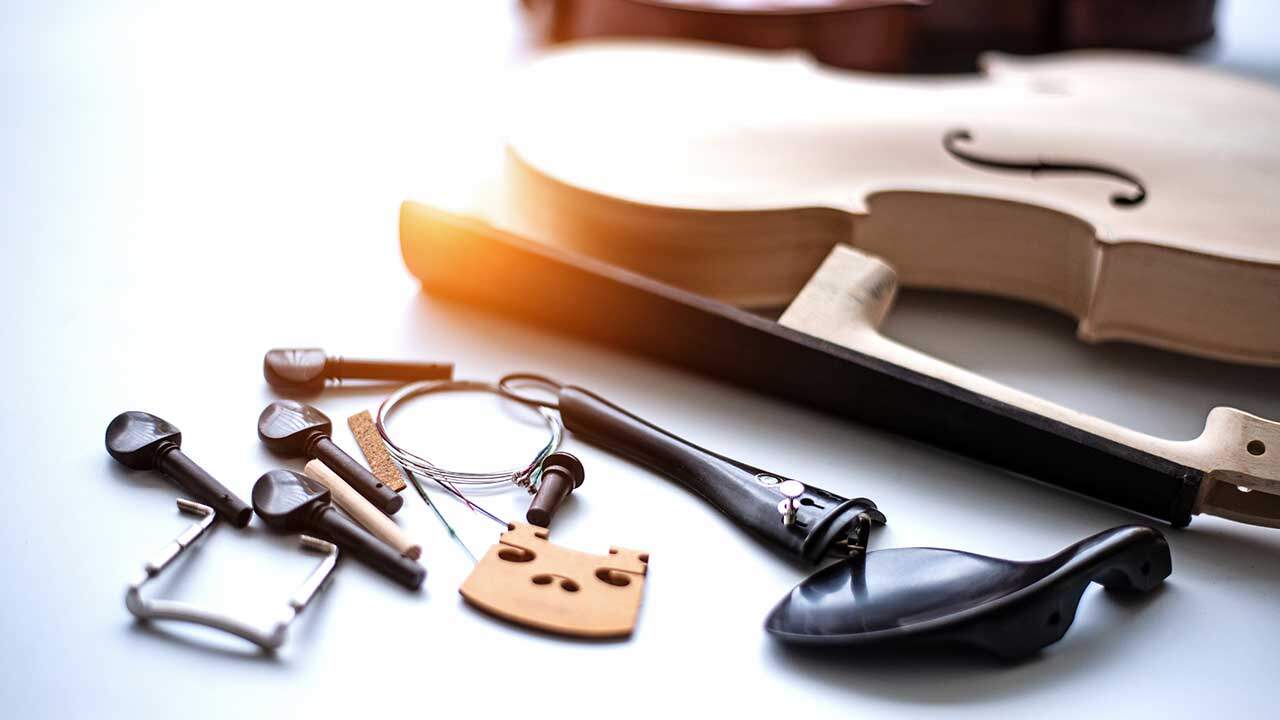
When it comes to playing the violin, learning what the different notes and finger placements are is important. It’s also important to understand what the different violin parts are and what they do.
We will go through the different parts of the violin in this post. Follow along on your violin or a violin parts diagram.
What Are the Parts of A Violin?
- Scroll: This is the easiest of the violin parts names to remember because it is the uppermost tip of the violin. The piece that is curved like a scroll.
- Pegbox and Tuning Pegs: Right next door to the scroll is the pegbox with the tuning pegs. This is where you will tighten or loosen the strings when they are out of tune.
- The Nut: This connects the fingerboard to the pegbox. It is grooved so that the strings are evenly spaced.
- The Strings: These are tuned from the lowest note to the highest. It is worth investing in good quality strings as this makes a huge difference to the sound produced.
- The Neck: This is the section of the violin that takes the most strain from the strings. It is the piece of wood that is glued to the back of the fingerboard.
- The Fingerboard: This is the black area that is glued to the front of the neck. It is where you will place your fingers when playing.
- The Body: This is the main part of the violin and is primarily hollow. The hollow spaces help to improve the sound quality and make it louder.
- The Sound Post: This is a post that is in the body of the violin, and that joins the front and back piece. This helps to improve the sound and also helps to improve the structural integrity of the violin.
- The F-Holes: These are the holes that look similar to scrolls on the body of the violin. They help to direct sound when you are playing.
- The Violin Bridge: This is located near the bottom of the violin. It is the piece of wood that holds the strings up and away from the body of the violin. The shape of the bridge influences how easily notes can be played.
- Fine Tuners: You may have one tuner on each string or just a tuner on your E string. For beginners, the former is easier to use. These help tighten the strings in smaller increments.
- The Endpin/ Tailpiece: The strings are attached to the bottom of your violin by the tailpiece.
- The Chin Rest: This gives you somewhere to rest your chin when playing and makes it easier to get the violin into the right position.

![]()
Violin Bow Parts
- The Hair: This is what creates the sound when it is scraped across the strings. You will need to use rosin on it so that it can get some grip on the strings and thus produce a sound. Even the best violin bows need to be repaired, and this is what is replaced.
- The Frog: This is the part at the bottom of the bow that attaches the bow and the stick.
- The Screw: This is used to alter the tightness of the hair in the bow.
- The Stick: This provides some structural support for the hair.
- The Pad: This gives you a surface to grip when playing.
![]()
Where Can I Buy Replacement Violin Parts?
If you have a music supply store in the town that you live in, you might be able to get the parts that you are looking for there. It does, however, pay to look online because you can normally get better deals that way.
What’s the Difference Between Parts and Accessories?
Violin parts are best described as essential to the violin. i.e., you will not be able to play the violin without them. So, things that are integral parts of the violin, like the strings, the fine tuners, etc.
Accessories, on the other hand, are useful additions. They are not essential, but they do enhance the experience of using the violin. This would include things like a shoulder rest or rosin for the strings.
![]()
Which Parts of the Violin Wear Out Quickly?
The strings are bound to wear out the most quickly, and so it is essential to always have spare strings on hand. The bow of the violin needs to be properly cared for so that it lasts longer, but it will also wear out more often than most other parts.
Once you become more experienced with using your violin, you will understand what an important role each of these parts plays. Don’t get too caught up by the names though. Over time, your violin starts to feel like an extension of yourself. You’ll know what each part does, and have a great sense of when it needs attention of any kind.



Leave a Reply